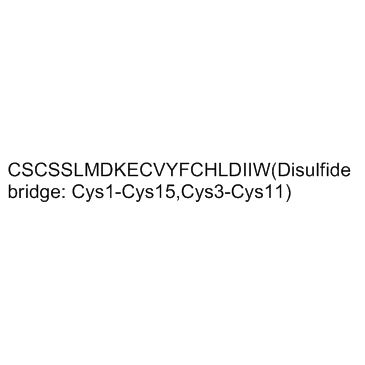Endothelin 1 swine, human |
| Catalog No.GC30485 |
Endothelin 1 swine, human is a synthetic peptide with the sequence of human and swine Endothelin 1, which is a potent endogenous vasoconstrictor.
Products are for research use only. Not for human use. We do not sell to patients.

Cas No.: 117399-94-7
Sample solution is provided at 25 µL, 10mM.
Endothelin 1 (swine, human) is a 21aa peptide vasoconstrictor and agonist of endothelin (ET) receptors ETA and ETB (IC50s = 0.15 and 0.12 nM, respectively) [1]. Endothelin 1 (swine, human) is the endothelin generated in the endothelium, where it acts in a paracrine or autocrine manner on ETA and ETB receptors on adjacent endothelial or smooth muscle cells [2].
Endothelin 1 (swine, human) activats endothelin-A receptor (ETAR) and drives epithelial-to-mesenchymal transition in ovarian tumor cells through b-arrestin signaling. In cultured mouse podocytes, Endothelin 1 (swine, human) caused loss of the podocyte differentiation marker synaptopodin and acquisition of the mesenchymal marker a-smooth muscle actin. Endothelin 1 (swine, human) promoted podocyte migration via ETAR activation and increased b-arrestin-1 expression [3].
The Endothelin 1 (swine, human) (1nmol/kg) produced strong pressor responses in the anesthetized rats in vivo [4]. Mice received an intradermal injection of 1-30 pmol Endothelin 1 (swine, human) and were caused dose-dependent scratching bouts [5]. A subpressor dose of ET-1 administered to rats was found to increase glomerular permeability and inflammation as well as the excretion of the glomerular slit-diaphragm protein nephrin, effects that could be blocked by an ETA receptor antagonist [6]. The magnitude of the ET-1 rise during antiangiogenic treatment may be useful biomarker of the efficacy of treatment [7].
References:
[1]. Kikuchi T, Kubo K, Ohtaki T, et al. Endothelin-1 analogues substituted at both position 18 and 19: highly potent endothelin antagonists with no selectivity for either receptor subtype ETA or ETB[J]. Journal of medicinal chemistry, 1993, 36(25): 4087-4093.
[2]. Schiffrin E L. Role of endothelin-1 in hypertension and vascular disease[J]. American journal of hypertension, 2001, 14(S3): 83S-89S.
[3]. Buelli S, RosanÒ L, Gagliardini E, et al. β-Arrestin-1 drives endothelin-1-mediated podocyte activation and sustains renal injury[J]. Journal of the American Society of Nephrology, 2014, 25(3): 523-533.
[4]. Inoue A, Yanagisawa M, Kimura S, et al. The human endothelin family: three structurally and pharmacologically distinct isopeptides predicted by three separate genes[J]. Proceedings of the national academy of sciences, 1989, 86(8): 2863-2867.
[5]. Trentin P G, Fernandes M B, D'OrlÉans-Juste P, et al. Endothelin-1 causes pruritus in mice[J]. Experimental biology and medicine, 2006, 231(6): 1146-1151.
[6]. Saleh M A, Pollock J S, Pollock D M. Distinct actions of endothelin A-selective versus combined endothelin A/B receptor antagonists in early diabetic kidney disease[J]. Journal of Pharmacology and Experimental Therapeutics, 2011, 338(1): 263-270.
[7]. Lankhorst S, Jan Danser A H, van den Meiracker A H. Endothelin-1 and antiangiogenesis[J]. American Journal of Physiology-Regulatory, Integrative and Comparative Physiology, 2016, 310(3): R230-R234.
Average Rating: 5 (Based on Reviews and 29 reference(s) in Google Scholar.)
GLPBIO products are for RESEARCH USE ONLY. Please make sure your review or question is research based.
Required fields are marked with *





